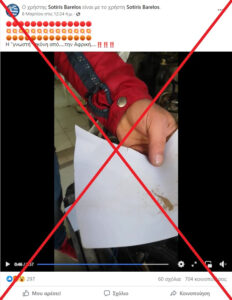Contrary to unfounded claims circulating on social media, the magnetic qualities of African dust are not proof of the existence of chemtrails. Dust from the Sahara desert, which is often detected in Greece and elsewhere in southern European, naturally contains minerals with magnetic qualities. But these magnetic properties are not proof that “we are being sprayed”, as posts on social media suggest, referring to an unfounded conspiracy that chemicals are deliberately dropped from planes. According to experts who talked to AFP, the minerals in African dust are not known to present a direct threat to human health. Dust particles can, however, bother people with respiratory problems.
One of the Facebook posts shares a video that shows a man collecting dust from his car on a piece of paper. He brings a magnet close to the dust and it sticks. “And look at this: the dust is magnetic. Otherwise, they say they don’t spray us with anything, that we should be calm,” he says. “The famous dust from….. Africa,” reads the text with the post.
The post was published on March 8, 2023 and has been shared more than 700 times since. The same claim has also appeared in other social media posts, such as here.
AFP spoke to experts in the fields of mineralogy and mineral chemistry who explained that the magnetic properties of African dust are completely natural and have their origins in the characteristics of the landscape of northern Africa. The chemtrail conspiracy has never been proven, with leading scientific institutes considering it to be baseless.

Sahara dust is naturally magnetic
AFP contacted experts who have studied the dust from the Sahara desert in northern Africa that is regularly blown up into southern Europe.
“It is a well-known fact that Saharan dust (and desert dust in general) is rich in iron oxides; indeed, about 6-7% by weight of Saharan dust is made up of such iron oxides (mainly magnetite and hematite), and they are strongly magnetic,” explained Juan Cruz Larrasoaña, staff scientist at the Instituto Geologico y Mineral de España, in an email to AFP on March 14, 2023.
Magnetite is the most magnetic natural material, said Athanasios Godelitsas, professor at the Geoenvironment Department of the University of Athens, told AFP on March 16, 2023. “Hematite is another iron oxide but which does not have as strong magnetic properties as magnetite. We also find ferric hydride in Sahara dust. All three are trivalent iron oxides. There are millions of tons of these minerals in nature throughout Greece,” he said.
The existence of magnetic chemical compounds in Sahara dust is completely natural and is not related to human activity. “Oxygen and iron are two very common elements in the Earth’s crust, and magnetic minerals are virtually present in all types of rocks, in amounts that can be small but detectable,” explained Larrasoaña, who has studied the magnetic properties of ancient marine and lake sediments.
“So, although seeing the dust getting attached to the magnet is actually amazing, it should not be considered a surprise after all,” he said.
Godelitsas added that the elements in Sahara dust do not present a health risk, as far as is known. Furthermore, his research had “found no engineered or episodic particles that could present a hazard, neither did we find any radioactivity”.
“Beyond that, there may be other chemicals in Saharan dust that could potentially harm the human body, but we don’t know for sure because no study has been done. It may have some lead or arsenic in it. Winds blow through waste sites in the Sahara desert, and there have been wars, so some areas may be polluted,” said Godelitsas. Around 90 percent of this dust ends up in the sea, he added.
Some vulnerable people, for example with lung problems, may be bothered by the particles of the dust, the US Centers for Disease Control (CDC) says. “People most likely to experience health problems caused by exposure to Saharan dust include the following: children and babies; older adults; people with underlying lung conditions; people with chronic cardiopulmonary diseases,” it says on its website.

How does Sahara dust appear in Europe?
Elena Floca, director of the Natural Environment and Meteorology faculty of the Physics Department of the University of Athens, explained in an email to AFP on March 29, 2023 how dust from Sahara arrives in Europe, including in the form of “mud rain”.
“African dust is transported through (atmospheric) depressions that form in northwest Africa, near the Atlas Mountains, called Saharan depressions. The maximum frequency of these depressions occurs in spring (March to May). The dust is transported to the surface […], rises into the troposphere (about 11 km from the ground) and is transported by the air stream at this height to the Western Mediterranean or Eastern Mediterranean. Depending on whether moisture is present, this dust will be suspended in the atmosphere, or deposited on the ground, or will form a condensation nucleus in clouds and be deposited by rain on the ground (mud rain).”
This is an old phenomenon that has likely been taking place for thousands of years, said Stavros Ntafis, physicist and research associate at the National Observatory of Athens, on March 29, 2023. “We know about the phenomenon of mud rain already from ancient times. Homer writes in the Iliad about ‘bloody raindrops’, drops of blood falling from the sky, which he attributed to the rage of Zeus,” he said.
This video (archived here) of the meteorological projection website meteo.gr explains the phenomenon.
Despite climate change, the phenomenon does not show an increase in frequency over the last years. “There is no statistically significant trend of an increase in the frequency of Saharan depressions carrying African dust in recent years that can be explained by climate change. On the contrary, there is a trend of decreasing cyclonic tracks in the Mediterranean accompanied by a decrease in precipitation in the present and future climate,” explained Floca.
Researchers suggest that the phenomenon might even become increasingly less frequent in the future.
Chemtrails conspiracy
These social media posts falsely attempt to link Saharan dust to the chemtrail conspiracy, which asserts that trails left behind by aeroplanes contain chemicals that are purposefully disseminated to, for example, control the population or impose specific ideas.
The conspiracy theory has been refuted several times in the past, with websites such as Contrail Science dedicated to proving it is false. According to most scientists who have studied the phenomenon, the traces left behind by airplanes are actually condensed gases emitted from their engines. These are known as contrails.

The fact-checking organization Ellinika Hoaxes has published an article in which it analyses the chemtrails conspiracy theory and provides scientific opinions debunking it.
The David Keith’s Research Group at the University of Harvard — which studies climate science, technology and geomechanics — says that the development of a large-scale chemtrails project, as evoked in the conspiracy, could not be hidden from the public. “It would be extraordinarily hard to keep such a program secret because it would be so easy for a single individual in the program to reveal it using leaked documents, photographs or actual hardware,” reads this article on their website.






